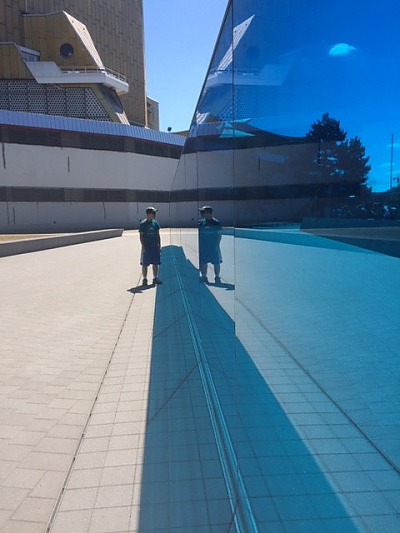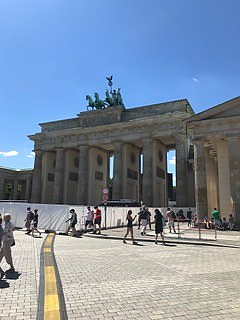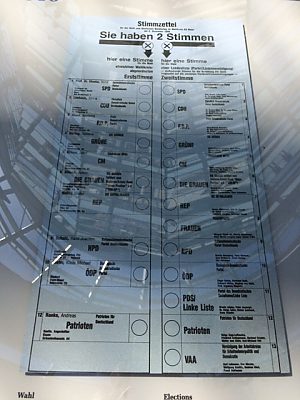More Student Reflections on their Adventures and Experiences in Berlin
We are coming into the homestretch of our program. Today we visited the Reichstag, and the memorials to the Roma/Sinti and homosexuals. Students are now working on their final projects, due on Friday.
Below, are pictures of the T4 Memorial, the Brandenburg Gate, and a ballot prior to the Nazi's assuming power.
Visiting the Jewish Museum
We went to the Jewish Museum of Berlin today. The architect, Daniel Libeskind, is a genius with few peers. The area with the axes was tilted and convoluted, giving a feeling of what it must have been like. The axis of exile was particularly striking, being tilted fairly hard and having large stone pillars, making it disorienting and unnerving. That was after you had to go out a steel door, which gave the feeling of an inability to return. There were also two other axes, the axis of holocaust, and axis of continuity. The axis of holocaust had many artifacts and things people had to leave behind, and the axis of continuity didn’t really have anything in it but a hallway that led to the stairs. The part of the museum that was the most heart wrenching had to be the exhibit called Memory Void. It was a passage with large concrete walls on the side. The floor had thousands of metal faces on it, symbolizing the Jews murdered. The faces made loud clinking and clanging noises as you walked on them, reminiscent of the sounds of heavy chains, like that of prisoners. The faces all looked anguished, some of them even having been welded in ways to look like they were crying. They were all of varying sizes, but many were around the size of a young child’s face. The culmination of all of this was an overwhelming feeling of sorrow.
Andrew Resnick
Boat Tour of Berlin
The Day of July 1st was not a dull one in the slightest. I woke up feeling fatigued but needed to rush for preparation for the boat trip. I quickly put on my shoes, grabbed my possessions and headed downstairs for some breakfast. I soon discovered something very ghastly that shook my very core; there was no breakfast. I quickly bolted at the speed of an energetic turtle; to a local pizzeria. I sporadically ordered whatever was found at the display counter. With exactly ten minutes remaining I jolted to the rendezvous point and began shoveling down two large square slices of pizza. I had just finished preciously before we left.
It was a bright blue day, with only a few clouds in the air; the perfect day for a boat ride. The ride would show people the mesmerizing sites of Berlin while giving a bit of background information. As the boat ride commenced I listened to the all-powerful device which gave me information about each historical landmark; in an English translation. The boat bobbed and weaved; while navigating through the hellish waters at a nice ten miles per hour pace. I for one was starting to become quite weary and decided to take part in the second greatest American past time; napping. The trouble in accomplishing my arduous goal was that I was sandwiched next to six other people; sitting at one table. So, I made the very calculated plan by trying to sleep in a normal sitting position; upright with my legs bent. After maybe 30 minutes the plan was deemed a failure since my head was awkwardly placed in a downward direction since there wasn’t a pillow to rest it. I instantly came up with a second plan. I was going to adjust my chair’s location where I’d then rest my head on my shoulder to use as a pillow function. This idea was a bust since it greatly bothered my shipmates and I still didn’t get any sleep.
After the sleep-deprived boat ride, I separated from my group to go on a quest; to find a restroom. I traveled far to find the place known as a restroom. I walked across a Madame Tussaud's on my quest; which gave me the thought of melting all the wax sculptures and riding them with a conveniently placed surfboard, but sadly I never followed through. After a couple of kilometers of walking, I finally found a restroom. I wandered into an art building where I noticed a theatrical show was having its run. I took the elevator straight to negative one to dispose of the unnecessariness. Afterward, my quest was fulfilled; I decided to do some snooping around the area. Sadly, I found nothing since everything was locked.
After leaving the theatrical restroom I unintentionally wandered into a town's square in Berlin. I then snuck into a tour group to learn about the area, free of charge. The tour leader explained that area is where the University of Humboldt is located. Humboldt, she explained, had many important students including the Grimm Brothers, Friedrich Engels, and Karl Marx. She then spoke about the Nazi book burning which occurred in 1933 and the effects that it had on the German folk. This led to her explaining how Germany, after reunification, came to terms with their horrible past by setting up memorials, plaques, and museums to teach people about the events of World War II. The guide then showed us the memorial for the Nazi book burnings, which is empty bookcases that could hold twenty thousand books. Leaving this area, I felt upbeat for what I’ve accomplished but also frustrated by the act of burning books from such a nasty area in history.
Henry Tobias Mandler
The Berlin Boat Tour begins in the heart of Berlin, starting on a loop around the cities most iconic and relevant spots. The boats leaves port, and cruises through the iconic Berlin scene, green leafy trees, bridges, riverside parks, and bike paths, while on the aesthetically pleasing vessel, experiencing the first class service. The tour is given in German on an automated voice over a loudspeaker, while the foreigners listen using a black stick that speaks in their respective language. As a foreigner and English speaker, I was subjected to using the speech stick, but I happened to be handed one that was defective, so for the first 30 minutes or more of the journey, I was behind on all the stories of the lands we past. Nonetheless, I was able to trade my defective device with a working one, and was able to commence with the stories. As the capital of Germany, we were informed about the important figures that could be seen from the water, such as significant statues, the lands that hold important historical events, and of course, the capital buildings, not each and every one is precisely remembered for its function, but all hold the duties of the federal government of Germany. The tour goes through a mix of old Berlin, with the distinctive brick buildings, to the newly built sections sparing square, circular, and spherical forms, dominating structures, of power and modern innovation. Still, the scene as far as the water is concerned, is fairly consistent, calm, and featuring other tour boats that pass by and excite everyone on board. After the two and a half hour loop around the city of Berlin, we land back were we took off from, the tour stops, and were lucky to say that we still have much to experience in the city for the final week.
Christopher Ogle
Visiting Potsdam
On Saturday, June 30th, Dash, Matt, and I took the S-Bahn out from Berlin to the town of Potsdam. Dash took the trip in order to walk a particularly picturesque trail, but Matt and I chose to visit the Palace and Park of Sanssouci; Matt wanted to experience this unique piece of architecture himself, and I ended up just coming along for the ride. I ended up being fascinated by the area due to its unique place in German history, and the strange story behind its continued existence.The Palace and Park itself is absolutely gigantic; contrary to its name, it actually holds a total of five palaces, as well as a church, a Roman bath, a windmill, a Chinese tea house, and huge swaths of park land littered with statues and busts. What fascinated the both of us on first blush was the decidedly Greco-Roman aesthetic of the majority of the architecture and artwork – given the high temperature and sunny weather, we could very well have been sightseeing in Italy if we didn't know better. This was due to the preferences of the Prussian monarchs who lived there, particularly Frederick William IV. These palaces, situated in what would have been about a half a day's ride from the capitol back then, essentially functioned as summer homes for the Prussian royalty and their courtiers; Frederick, enamored with ancient Rome, chose to commission the vast amount of architecture and sculpture in order to essentially have a small piece of Italy close to home. (Further evidence of this yearning can be seen in the occasional smattering of grapevines in the park.) Strangely enough, this monument to opulence appears to have survived as long as it did because very few people cared about it. The Nazis ended up leaving the place alone, since Hitler decided that the remnants of the old monarchy were beneath him – part of his plans for Germany included even more extravagant living quarters for himself. The Soviets ended up not touching the palaces either, despite their usual tendency to deconstruct monarchistic relics and appropriate the resultant resources for the Union. As a result, most of the damage done to the structures was through neglect. When the park became a UNESCO World Heritage site in 1990, restoration of the statues and structures began, and the process was still being undertaken as of our visit. In total, I returned from this trip with an expectantly fascinating glimpse into the values of key individuals of the past. (Matt returned with over a thousand photos. Maybe you'll see a few!)
Adam Cook
The forests of Germany were once fast and flourishing with an abundance of wildlife. Now, though much more scattered, there are still lots of woods in Germany. Some of them quite big. While the forest outside of Potsdam are not the biggest or most well-known, they are quite beautiful and offer Berliners a break from the metropolitan area. I discovered this when I went on a hike through them this past weekend. The path I had chosen started at the train station. It had me follow a road called Brauhausberg until it split. I then followed a new road which went along Lake Templiner See. The lake was picturesque and had many boaters out enjoying the nice weather. In order to get back in time to get back to Berlin though, I had to try to cut the hike short. So instead of walking all the way to the next town, I cut through a trail through the woods to try to link up with the second half of the loop. Walking through the woods was refreshing and interesting. I was able to notice the differences between the species of trees. Eventualy, I emerged on a road which I thought marked the mid-point. I crossed and continued along a trail that gave way to power lines next to some train tracks. After a few kilometers, I thought I must have made a wrong turn and looked and saw that the tracks where much farther away from Potsdam then I had thought, and was now well on my way to another town all together. I backtracked and was able to get to the train station. However, walking though the wood showed just how diverse life could be. Though similar to the woods of New England, these woods had a different feel. Different species, different soil, and even at times a different smell. I hope Germany can keep their forests alive and grow them to help preserve the diversity of life.
Dash Katz
Visiting the Berlin Zoo
This weekend come of my classmates including myself went on an optional trip to visit the Berlin Zoo. When we went to the zoo we split up to check out what animal exhibits there were. Unfortunately, there weren’t as many animals as there were supposed to be. Most of the animals such as the lions and tigers weren't there and most of the apes in the ape exhibit weren’t there as well. We don’t know if it was because they were having lunch or had something to do with construction or health issues. However, then we went to the zoo aquarium where it was much more interesting. We saw all sorts of fish and other sea creatures. On the upper floor we saw reptiles and amphibians, which was great to see. There was even a Koi pond near the entrance. There were also some information galleries about how the zoo was founded and what it’s been though during World War II. As a child I’ve been to many zoos and I live near an aquarium so I already know what it’s like to see all these types of animals, but I still enjoyed going to a new place during this trip. The second trip today was a river boat trip around the city were we listened to a tour talking about different landmarks and historical places around the city river banks. It was very relaxing and informative and these weekend trips will be something I will remember when looking back at this trip.
Ethan Ilchert
Visiting Old Spandau
The town of Spandau was a refreshing Contrast to the hustle and bustle of Berlin. The old fortress and the old buildings and church provided the near countryside-esque vision of Germany. I hear Potsdam is more gardeny, which is exciting. The fortress held history from the Middle Ages to World War I with a dash of World War II. Exhibits ranging from cannons and weaponry to helmets and armor provided an excellent detailing of the fort itself which was very out of place being near a major road and modern buildings. It’s like someone put a fort from the pirate age of the Caribbean into a small lake of a town like a Boston suburb. Seeing all the helmets from each were dating back to the Middle Ages and leading up to World War I was very interesting. I could see symbology used by the Nazis in helmets from the Napoleonic era and even further back in time. The design of the helmets changed drastically from a strange cone-like hat to the first version of the German infantry of World War I. I look forward to seeing what this week’s adventures show me and how they might tie in to German history outside of the Nazi era.
Matt Ward












